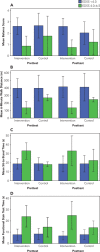Effects of a 10-week inspiratory muscle training program on lower-extremity mobility in people with multiple sclerosis: a randomized controlled trial
- PMID: 24453703
- PMCID: PMC3882946
- DOI: 10.7224/1537-2073-13.1.32
Effects of a 10-week inspiratory muscle training program on lower-extremity mobility in people with multiple sclerosis: a randomized controlled trial
Abstract
Pulmonary muscle weakness is common in ambulatory people with multiple sclerosis (MS) and may lead to deficits in mobility function. The purpose of this study was to examine the effect of a 10-week home-based exercise program using an inspiratory muscle threshold trainer (IMT) on the results of four lower-extremity physical performance tests in people with MS. The study design was a two-group (experimental-control), pretest-posttest study. Outcome measures consisted of pulmonary function measures including maximal inspiratory pressure (MIP), maximal expiratory pressure (MEP), and maximal voluntary ventilation (MVV), and the following lower-extremity physical performance measures: the 6-Minute Walk (6MW) distance, gait velocity (GV), the Sit-to-Stand Test (SST), the Functional Stair Test (FST), and a balance test (BAL). A total of 46 ambulatory participants (Expanded Disability Status Scale [EDSS] score, 2.0-6.5) with MS were randomly assigned to an intervention group (mean EDSS score, 4.1) that received 10 weeks of home-based inspiratory muscle training or a nontreatment control group (mean EDSS score, 3.2). Of the original 46 participants, 20 intervention group participants and 19 control group participants completed the study. Compared with the control group, the intervention group made significantly greater gains in inspiratory muscle strength (P = .003) and timed balance scores (P = .008). A nonsignificant improvement in 6MW distance (P = .086) was also noted in the IMT-trained group as compared with the control group. This is the first study directly linking improvement in respiratory function to improvement in physical performance function in people with mild-to-moderate disability due to MS.
Figures
Similar articles
-
A combined inspiratory and expiratory muscle training program improves respiratory muscle strength and fatigue in multiple sclerosis.Arch Phys Med Rehabil. 2013 Oct;94(10):1964-70. doi: 10.1016/j.apmr.2013.05.005. Epub 2013 May 25. Arch Phys Med Rehabil. 2013. PMID: 23714277 Clinical Trial.
-
Six-minute walk test for persons with mild or moderate disability from multiple sclerosis: performance and explanatory factors.Physiother Can. 2011 Spring;63(2):166-80. doi: 10.3138/ptc.2009-62. Epub 2011 Apr 13. Physiother Can. 2011. PMID: 22379256 Free PMC article.
-
Erratum.Mult Scler. 2016 Oct;22(12):NP9-NP11. doi: 10.1177/1352458515585718. Epub 2015 Jun 3. Mult Scler. 2016. PMID: 26041800
-
Inspiratory Muscle Training in Patients With Heart Failure: What Is New? Systematic Review and Meta-Analysis.Phys Ther. 2020 Dec 7;100(12):2099-2109. doi: 10.1093/ptj/pzaa171. Phys Ther. 2020. PMID: 32936904
-
Respiratory muscle training in children and adults with neuromuscular disease.Cochrane Database Syst Rev. 2019 Sep 5;9(9):CD011711. doi: 10.1002/14651858.CD011711.pub2. Cochrane Database Syst Rev. 2019. PMID: 31487757 Free PMC article.
Cited by
-
Predictors of positive outcomes following resistive inspiratory muscle training in non-ambulatory persons with advanced multiple sclerosis.Mult Scler J Exp Transl Clin. 2022 May 23;8(2):20552173211058862. doi: 10.1177/20552173211058862. eCollection 2022 Apr-Jun. Mult Scler J Exp Transl Clin. 2022. PMID: 35634011 Free PMC article.
-
Respiratory Strength Training in Amyotrophic Lateral Sclerosis: A Double-Blind, Randomized, Multicenter, Sham-Controlled Trial.Neurology. 2023 Apr 11;100(15):e1634-e1642. doi: 10.1212/WNL.0000000000206830. Epub 2023 Feb 20. Neurology. 2023. PMID: 36805435 Free PMC article. Clinical Trial.
-
The impact of respiratory muscle training on respiratory function in patients with neuromuscular disease: a systematic review and meta-analysis of randomized controlled trials.BMC Sports Sci Med Rehabil. 2025 Jul 2;17(1):168. doi: 10.1186/s13102-025-01198-z. BMC Sports Sci Med Rehabil. 2025. PMID: 40605068 Free PMC article.
-
Respiratory muscle training in neuromuscular disease: a systematic review and meta-analysis.Eur Respir Rev. 2022 Nov 29;31(166):220065. doi: 10.1183/16000617.0065-2022. Print 2022 Dec 31. Eur Respir Rev. 2022. PMID: 36450369 Free PMC article.
-
Respiratory muscle training for multiple sclerosis.Cochrane Database Syst Rev. 2017 Dec 21;12(12):CD009424. doi: 10.1002/14651858.CD009424.pub2. Cochrane Database Syst Rev. 2017. PMID: 29267988 Free PMC article.
References
-
- Gosselink R, Kovacs L, Ketelaer P, Carton H, Decramer M. Respiratory muscle weakness and respiratory muscle training in severely disabled multiple sclerosis patients. Arch Phys Med Rehabil. 2000;81:747–751. - PubMed
-
- Gosselink R, Kovacs L, Decramer M. Respiratory muscle involvement in multiple sclerosis. Eur Respir J. 1999;13:449–454. - PubMed
-
- Tantucci C, Massucci M, Piperno R, Betti L, Grassi V, Sorbini CA. Control of breathing and respiratory muscle strength in patients with multiple sclerosis. Chest. 1994;105:1163–1170. - PubMed
-
- Mutluay FK, Gurses HN, Saip S. Effects of multiple sclerosis on respiratory functions. Clin Rehabil. 2005;19:426–432. - PubMed
-
- Howard RS, Wiles CM, Hirsch NP, Loh L, Spencer GT, Newsom-Davis J. Respiratory involvement in multiple sclerosis. Brain. 1992;115:479–494. - PubMed
LinkOut - more resources
Full Text Sources
Medical
Miscellaneous

